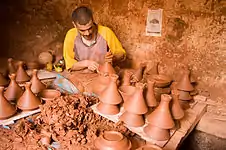Clay pot cooking
Clay pot cooking is a process of cooking food in a pot made of unglazed or glazed pottery.

Cooking techniques
Different cultures have different techniques of cooking food in clay pots. Some use pots that are fully finished by burnishing and therefore do not require the pot to be soaked each time before use. Some are unfinished and must be soaked in water for 30–45 minutes before each use to avoid cracking. The design and shape of the pot differ slightly from one culture to another to suit their style of cooking.
Seasoning is important to prevent cracking of the vessel when exposed to high heat. Clay pots are initially seasoned with oil and hot water but may be fully seasoned only after the first several uses, during which food may take longer to cook. It is also essential to avoid sudden temperature changes, which may cause the pot to crack. Heat should be started low and increased gradually both on the stovetop and in the oven.
The food inside the pot loses little to no moisture because it is surrounded by steam, creating a tender, flavorful dish. Water absorbed within the walls of the pot prevents burning so long as the pot is not allowed to dry completely. Because no oil needs to be added with this cooking technique, food cooked in clay is often lower in fat than food prepared by other methods.
In Asian cuisines
South Asia
In the southern states of Andhra Pradesh, Kerala, Tamil Nadu and Telangana in India, the traditional pot used for cooking is called a chatti. There are many different types of pots used in the different cultures of North India, Pakistan, Bangladesh.
India
In northern states including Punjab, Uttar Pradesh, Haryana, Rajasthan, the cooking pots are called handi. Traditionally, Indian chefs could cook many dishes simultaneously by stacking handi while cooking. In southern states of Andhra Pradesh, Kerala, Tamil Nadu and Telangana, the cooking pots are called 'man panai','man satti' in Tamil, 'kunda', 'matti kunda', 'kadava' in Telugu. The traditional pot used Tamil Nadu 'pongal festival' In eastern states, Champaran mutton is a delicacy.
Sri Lanka
People in Sri Lanka use clay pots to make many dishes including pahi (“little jackfruit”) fish curry, called abul thiyal; accharu, a chutney; as well as some meats, rice, and several types of freshwater fish called Lula, Hunga, Magura and Kawaiya.
Greater China

In China, the pot used for such cooking is generally known as shaguo (Chinese: 砂鍋; pinyin: shāguō; Cantonese Yale: sāwō) or boujai (Chinese: 煲仔; Cantonese Yale: bōu jái), a Cantonese word for “little pot”. Clay pot dishes are sometimes labeled as “hot pot” or “hotpot” dishes on the menus of Chinese restaurants in English-speaking areas of the world, but they should not be confused with hot pot dishes that are served in a large metal bowl and cooked at the table. In Taiwan, the chicken dish sanbeiji is prepared in a clay pot.
Korea
In Korea, the earthenware pot is called ddukbaegi, often used for soups as seen in Korean restaurants. The stone pot is called dolsot, which is heavier and has a more marbled appearance, used to cook dolsot bibimbap.
Vietnam
The stew-like dish kho is cooked in a pot. The pot is most often called nồi đất in Vietnamese, although, depending on its size and use, it may also be called nồi kho cá, nồi kho thịt, nồi kho tiêu, or nồi kho tộ.
Philippines
The traditional pot used for cooking is the palayok.
Indonesia

The traditional pot used for cooking is called kuali or gentong. The famous cuisine is empal gentong (beef with coconut milk soup). Chinese Indonesian sapo tahu is tofu and vegetables cooked in claypot.
In African cuisines
Ethiopia
Traditionally, all food was cooked in specialized clay pots. Some traditional dishes are still cooked in clay pots as the same flavor cannot be achieved with metal cookware.

Morocco
The tajine is a North African, two-piece pot used in Moroccan cuisine. The bottom part is a broad, shallow bowl, while the top is tall and conical, or sometimes domed. The tall lid acts to condense rising steam and allow the moisture to roll back down into the dish.[1] The tajine lends its name to the meat stew that is typically cooked in this pot.
In European cuisines
Germany

Clay roasting pots called Römertopf (“Roman pot”) are mainly used to cook meat or stew in the oven. Since its introduction in 1967, it has influenced cooking traditions in Germany and neighbouring countries.
Spain
In Spanish cooking a ceramic roaster known as olla de barro is used.
In South American cuisines
Clay pots are used in various South American dishes.
In North American cuisines
Native American civilizations traditionally cooked in clay pots, although they fell out of favor after European settlers' introduction of metal cookware. In the modern United States some cooks choose to use clay pots for health or environmental reasons.
References
- Wolfert, Paula (2009). Mediterranean Clay Pot Cooking: Traditional and Modern Recipes to Savor and Share. Hoboken, N.J.: John Wiley & Sons. ISBN 9780764576331.
- Barbara Goldfield (18 October 2011). "Pizza, Pane & Pignata". ItalianNotebook. Retrieved 12 August 2016.
- Alessia (17 November 2013). "La "Pignata"". Il Sud che non ti aspetti (in Italian). Retrieved 12 August 2016.